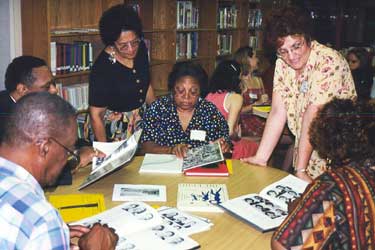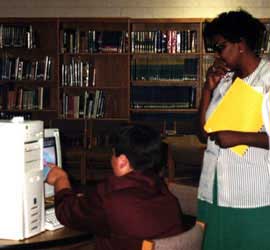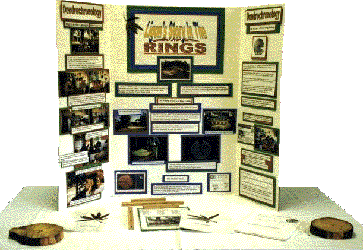School Connecting to Community: An Exposition
Sharing the Project Products
By the end of the school year, the various middle school classes
had developed projects and products worthy of presenting to the alumni
who'd been the subjects, either directly or indirectly; of their research.
An exposition of the work was held in early June to communicate and connect
with the alumni who had inspired the project, for the students to view
and present what they had accomplished and for all in the project to see
one anotherís progress and products. Alumni, students, parents, teachers,
university professors and graduate students attended. The governor of North
Carolina made a brief visit. Held in the school's media center, the exposition
had several stations where visitors would see either virtual or actual
exhibits or products. A variety of activities were included. Alumni gathered
over yearbooks to greet old friends and share memories. Students shared
their projects. Student exhibits included three GIS projects, the Ligon
High School History web site, yearbooks, dendrochronology,
the book of interviews:
Capture
the Past to Guide the Future, a video tape of selected interviews
with photos of memorabilia, and architectural history studentsí reports.
Professors and teachers explained the collaboration and shared future plans
for this project - an on site museum of school history and an "Earth Quilt"
that will become a stop on Raleigh's Millennium Trail. Refreshments were
provided by parents and students from Ligon's Silver Strings Orchestra
provided background music.
Visitors were surprised and impressed by the level of sophistication
the middle school students demonstrated in each of the interdisciplinary
products. Honored guests included alumni, Johnny Burke (a former Ligon
High School teacher and Wake County principal), Dr. Charles Haywood (a
former Ligon High School alumnus and teacher and current Associate Vice
Chancellor of Student Affairs at NCSU), parents, community partners, and
graduate students.
Alumni Gathering

|
|
Alumni share memories with Dr. Anna Wilson
|
The Ligon Alumni Association, a vibrant and active organization, meets
annually, organizes trips, and take frequent opportunities to reunite.
Over twenty alumni attended the exposition. Some had been both students
and teachers at Ligon High School. Some of those attending have already
retired from productive careers. Many served in the military. Many are
or were educators. Three are currently professors at North Carolina State
University. One is currently Associate Vice Chancellor of Student Affairs
at NCSU. Several of the guests who graduated from Ligon High School have
children who are students at Ligon GT Magnet Middle School.
GIS Displays
Mr. Hunter's Life Map, Find Your House, Railroads in NC, LHS Web Site,
Scanning Station
 |
Author Linda Simmons-Henry gets a GIS demonstration from a middle school
student. Ms. Simmons-Henry learned of the project through an interview
by a graduate student and became involved when she heard that the current
principal supported in-school museum exhibit space. An invaluable source
of knowledge about the community and Historically Black Schools in North
Carolina, Ms. Henry looks forward to participating in the next phase of
the project. |
In the GIS section, there were five stations, including three GIS projects.
Students at one station shared the GIS model of Mr.
Hunter's Life Map. The street layers for this project were geocoded.
With the alumni, students emphasized a named extent that showed the downtown
Raleigh area, asking questions to glean information that will help us improve
our map of Raleigh in the 1950ís. Students at another station used DOQQs
overlaid with the geocoded county street maps to help people find their
homes. Alumni were encouraged to find their high school home and their
current home. Another student shared his GIS project that showed the historical
development of railroads using scanned historical maps and new themes he
created based on his research to show this development. The student explained
how the development of railroads influenced the growth of the state with
Raleigh as its capital. At the fourth station, GIS students shared the
web site as it existed and the draft of the planned web
site. Students encouraged the alumni to look at Mr.
Hunter's biography to show how it was used to depict information for
the mapping project. The final station was set up with a scanner and digital
camera to collect archival information from yearbooks, etc. that alumni
brought to share. Information collected at this station will be used to
create hotlinks in GIS models and to enhance the web site and future books.
Students introduced the technology, since most guests had no idea what
GIS meant.

|
This student has taken every GIS elective offered. She demonstrates
the Ligon
High School History web site to visitors. A native of Southeast Raleigh,
Dana was bused across the county during her elementary school years. One
of the paradoxes of desegregation has been the uprooting of minority children
and the fragmentation of their communities to achieve acceptable rates
of integration across a county-wide school system. |
Wake County Heritage Displays
Architectural History and Biographies
A social studies elective in Historic Architecture taught by Neville
Sinclair coordinated information on buildings important to the Black community
and on the lives of two important men in the Southeast Raleigh community;
J. W. Ligon and John Chavis. The social studies elective will continue
this year's research next year with the help of faculty and graduate students
from NCSU's Public History department and St. Augustineís College.
Journalism Displays
Capturing the Past to Guide the Future
 |
Alumni who were interviewed received a copy of "Capturing
the Past to Guide the Future" and a videotape of selections from the
first round of interviews. Editor Betty Mackie plans to produce future
interview compilations with her journalism classes. Students learned interview
techniques, the writing and editing of oral histories, and established
positive relationships with the alumni and facilitators. |
Journalism students taught by Betty Mackie conducted the first fourteen
interviews that are compiled and published in "Capturing
the Past to Guide the Future." Students learned interview techniques
in demonstrations by Dr. Wilson interviewing Mr. Hunter and Mrs. Merritt.
Students worked in teams to interview alumni with a graduate student, teacher,
or professor as a facilitator. A graduate student transcribed the tapes
of the interviews. The middle school students used their notes and the
transcriptions to write a biography of each alumnus. Most interviews were
conducted at Ligon.
Dendrochronology Displays
Ligon's History in the Rings

|
 |
| Dendrochronologists displayed the tree cookies, the proposed museum
display, this poster with pictures and details of the processing of the
tree rings, and a PowerPoint
presentation about their study. |
Alumni were asked to contribute events that occurred during their high
school years that could appear as part of the in-school "Ligon's History
in the Rings" exhibit being developed by the science class. |
A science class at Ligon studied dendrochronology
as one aspect of this project. Using "tree cookies" cut from a willow oak
felled during the renovations to help tell the school's story. Virginia
Owens, a science teacher, partnered with NCSU Department of Wood and Paper
Products to preserve the tree cookies. Students in the science classes
learned how to date the tree rings and what information they could gain
from them. They were guided through the process by foresters from the US
Forest Service and NC Extension Service. They plan to trace the history
of the school as it corresponds to the growth of the tree. Permanent displays
will be created to tell the story of the school from the tree's perspective
and for further study of dendrology. Becoming familiar with
CITYgreen
software, she hopes to expand the dendrochronology unit to include ecological
health, urban forestry and to connect to her Neuse River watershed curriculum.
Interdisciplinary Team

|
The interdisciplinary collaboration allowed us to record many aspects
of the history of Ligon High School. Ann Thompson: Educational Technology,
Ligon Historians, and GIS; Virginia Owens: Science: Dendrochronology; Rita
Hagevik: Science and GIS; Neville Sinclair: Social Studies: historic architecture;
and Betty Mackie: Journalism and oral histories. |
University Professors

|
Archivist/Author Linda Simmons-Henry and Dr. Marsha Alibrandi discussed
the collaborative partnership. Dr. Alibrandi served the project as Principal
Investigator and GIS education researcher. |
| University professors of Historiography and Middle School Education;
one an author of school desegregation history; the other of a history of
Raleigh, were among the project's partners. Both contributed time and expertise
to the middle school classes involved. Dr. Wilson demonstrated oral history
interviewing techniques, and Dr. Beal led field trips on Raleigh's history. |

|
This exposition was vital to the success of the project. Teachers and
students worked hard to prepare displays that effectively communicated
their aspect of the project. For the first time everyone could see the
scope of the project. The spirit of the evening and the synergy within
this inter generational, multicultural group drawn together by their common
interest in Ligon inspired all to commit to continue the project.
Return to Exploring the Past to Influence the Future
Background Information about the School | School
Connecting to the Alumni | School Connecting with
the Community
Background on the Collaboration | Community
Connecting with the School | Connecting Students
with Community Partners
Role of GIS in the Project | How
did students benefit from the project?
...To Guide the Future











